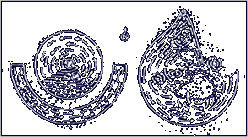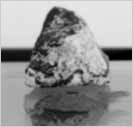 |  | 

Below: Diagram of the Yatesbury formation courtesy Peter Sorensen
In August 1993, fine-grade iron filings were loosely sprinkled within a freshly made crop circle, creating a covering of what was later referred to as a glaze of 'grey dust'. The discovery of this led to analysis by an American biophysicist, Dr WC Levengood, which provided, "...rare, direct evidence", that the formation itself - in the shape of a geometric 'Nautilus' - was created by a previously hypothetical meteorological mechanism: the 'Ion-Plasma Vortex'. This was supported by further evidence which showed that the 'grey dust' had emanated from an atmospherically reduced meteorite - specifically, part of the Perseid shower. The dust had been brought down to earth in a molten state... The discovery of this led to analysis by an American biophysicist, Dr WC Levengood, which provided, "...rare, direct evidence", that the formation itself - in the shape of a geometric 'Nautilus' - was created by a previously hypothetical meteorological mechanism: the 'Ion-Plasma Vortex'. This was supported by further evidence which showed that the 'grey dust' had emanated from an atmospherically reduced meteorite - specifically, part of the Perseid shower. The dust had been brought down to earth in a molten state...
"The first distinguishing characteristic in the sample was magnetic susceptibility. Some of the smaller pieces of rock and wheat could be turned over and picked up by a magnet. Spectroscopic analysis revealed the material in the coating or 'glaze' to be composed of iron and oxygen only. It is extremely unusual to find only these elements and no others present. Specrtographs of the soil showed the normal components of calcium and silicon common to such soils. If the iron content had come from the soil it would have still had at least traces of calcium and silicon in it. We could find no terrestrial system that could account for this and began to consider meteors as a possible source. (...) While finding meteoric dust in a crop circle is exiting, it is not the most important part of the discovery. Rather, the real value of this finding lies in the way the material impacted the ground. Normally crop circles occur in normal air and there is nothing left around afterwards to indicate what happened in that air. Here we had a second medium - magnetic dust particles in the air. These were not laid down randomly. Bear in mind these were found only in the smaller, sub-swirls within the larger formation and nowhere else. Also note that they were fused together. This is not normal. (...) The wheat was subjected to the standardised crop-formation tests in Dr Levengood's laboratory. There were dramatic differences between formation samples and controls from outside the formation both in terms of growth difference in the seeds and conductivity changes in the bract tissue (the so-called 'alpha test'). This is exactly consistent with the results in previous crop formations. (Samples flattened by man and examined in 1993 had no such changes.) In other words, this was not a hoaxed formation. (...) CONCLUSION: This incident provides rare, direct evidence for a theoretical model of crop formation - the plasma vortex - that had previously been indicated only in an indirect way. If there is any other explanation for the evidence in hand we are eager to hear it from anyone and invite immediate communication. If the iron content had come from the soil it would have still had at least traces of calcium and silicon in it. We could find no terrestrial system that could account for this and began to consider meteors as a possible source. (...) While finding meteoric dust in a crop circle is exiting, it is not the most important part of the discovery. Rather, the real value of this finding lies in the way the material impacted the ground. Normally crop circles occur in normal air and there is nothing left around afterwards to indicate what happened in that air. Here we had a second medium - magnetic dust particles in the air. These were not laid down randomly. Bear in mind these were found only in the smaller, sub-swirls within the larger formation and nowhere else. Also note that they were fused together. This is not normal. (...) The wheat was subjected to the standardised crop-formation tests in Dr Levengood's laboratory. There were dramatic differences between formation samples and controls from outside the formation both in terms of growth difference in the seeds and conductivity changes in the bract tissue (the so-called 'alpha test'). This is exactly consistent with the results in previous crop formations. (Samples flattened by man and examined in 1993 had no such changes.) In other words, this was not a hoaxed formation. (...) CONCLUSION: This incident provides rare, direct evidence for a theoretical model of crop formation - the plasma vortex - that had previously been indicated only in an indirect way. If there is any other explanation for the evidence in hand we are eager to hear it from anyone and invite immediate communication. (If this formation can be described as man-made, then we and the scientific community of the world will be most eager to hear how the hoaxers managed to scavenge the atmosphere for meteoric dust, reheat it and lay it down just right with no contaminants. We assure you, you could support yourself nicely with such technological skills). The fact that the plant samples showed the same tissue and growth changes typically found by this laboratory in many other crop formation samples strongly suggests that this was a typical formation except for the fortuitous presence of meteoric dust. Thus we can expect that the mechanisms involved in this formation were typical of other formations as well. Thus the serendipitous involvement of magnetic iron dust in this formation has produced what we consider to be an important breakthrough in the conceptual understanding of the crop circle phenomenon". (If this formation can be described as man-made, then we and the scientific community of the world will be most eager to hear how the hoaxers managed to scavenge the atmosphere for meteoric dust, reheat it and lay it down just right with no contaminants. We assure you, you could support yourself nicely with such technological skills). The fact that the plant samples showed the same tissue and growth changes typically found by this laboratory in many other crop formation samples strongly suggests that this was a typical formation except for the fortuitous presence of meteoric dust. Thus we can expect that the mechanisms involved in this formation were typical of other formations as well. Thus the serendipitous involvement of magnetic iron dust in this formation has produced what we consider to be an important breakthrough in the conceptual understanding of the crop circle phenomenon".
John A Burke & W C Levengood - The H-Glaze Report (1994)
These findings were published in 'J.Scientific Exploration' (9:2,1995) a peer-reviewed scientific journal, but alternative analysis has confirmed that these effects were merely the result of iron oxidisation (rust), which occurred after heavy rain. Shown here is the actual container (with the remaining filings enclosed) that was used during the creation of the original formation. Also shown is a sample of the iron fillings, and an affected artifact from the original site.
Photos by: Rob Irving
|  |  |





